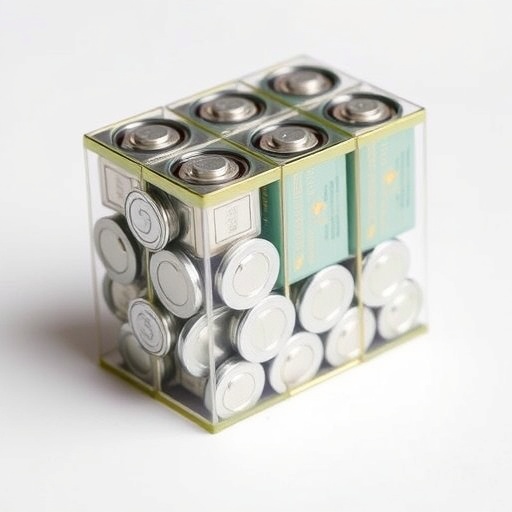In a groundbreaking development in the field of energy storage and recycling, researchers have made significant strides in synthesizing novel materials that can play a crucial role in pseudocapacitor applications. The team, led by renowned scientists including Querubino, Coelho, and Chaves, has successfully extracted valuable components from spent lithium iron phosphate battery cathodes. The synthesis focuses on creating β-LiFe₅O₈, α-Li₂FeO₃, and α-Fe₂O₃, showcasing a transformative approach that not only addresses waste management issues associated with battery disposal but also enhances the efficiency of energy storage systems.
As the world increasingly transitions towards renewable energy sources, the demand for efficient energy storage solutions is on the rise. Pseudocapacitors, which bridge the gap between conventional capacitors and batteries, have emerged as a promising technology due to their ability to deliver high energy and power densities while maintaining quick charge and discharge cycles. This synthesis not only optimizes energy storage capabilities but also contributes to sustainable practices in battery lifecycle management.
The innovative method employed by the research team involves the recovery of metal oxides from lithium iron phosphate battery cathodes that have reached the end of their lifecycle. By utilizing cutting-edge techniques in material science, the researchers successfully extract valuable iron oxides, transforming waste into a resource. This process begins with the careful disassembly of spent batteries, followed by a series of chemical treatments that isolate and convert the materials into highly functional oxides suitable for energy storage applications.
By synthesizing β-LiFe₅O₈, α-Li₂FeO₃, and α-Fe₂O₃, the researchers have unlocked the potential of these materials in the realm of pseudocapacitors. β-LiFe₅O₈, in particular, has garnered attention for its unique electrochemical properties, which enhance the overall performance of energy storage systems. Its high conductivity and capacitance allow for rapid charge transfer, making it an ideal candidate for applications where quick bursts of energy are necessary, such as in electric vehicles and renewable energy grids.
Moreover, the addition of α-Li₂FeO₃ complements the pseudocapacitor by contributing to the stability and longevity of the material. With its high thermal stability and excellent cyclic performance, α-Li₂FeO₃ helps in mitigating issues related to material degradation over time, a common challenge faced in energy storage devices. The combination of these metal oxides creates a hybrid material that not only maximizes efficiency but also ensures longevity, paving the way for more reliable and sustainable energy storage solutions in the future.
The implications of this research extend beyond the laboratory. As governments and industries ramp up efforts to transition to cleaner energy alternatives, the demand for reliable energy storage systems has never been more pressing. The successful synthesis of these metal oxides from recycled battery components offers a pragmatic solution to the challenges posed by obsolete batteries. The ability to repurpose waste into functional materials not only conserves resources but also reduces the environmental footprint associated with battery production and disposal.
In addition to the practical applications in energy storage, this research also opens avenues for further exploration in the field of material science. Understanding the properties and behaviors of β-LiFe₅O₈, α-Li₂FeO₃, and α-Fe₂O₃ at the molecular level can lead to the development of even more advanced materials tailored for specific applications. Future studies may focus on optimizing the synthesis process, enhancing material characteristics, and exploring new combinations of metal oxides that could further improve performance.
This significant advancement in the use of recycled materials underscores the importance of innovative thinking in addressing the challenges of a rapidly changing energy landscape. With the continued proliferation of lithium-ion batteries in consumer electronics, electric vehicles, and renewable energy systems, the long-term sustainability of materials used remains a critical concern. The ability to recycle spent batteries and transform them into high-performance pseudocapacitor materials represents a step forward in creating a circular economy within the energy storage sector.
As the research findings gain traction, industry experts predict a shift in how we perceive waste in the context of energy materials. The conventional view of battery waste as a liability is being transformed into an opportunity for innovation and sustainability. This paradigm shift not only benefits technology developers and manufacturers but also aligns with global sustainability goals, presenting a win-win scenario for both the environment and the economy.
The broader implications of this work may also extend to academic research, fostering collaborative efforts among institutions to explore recycling methodologies and the synthesis of new materials. This research serves as a reminder that interdisciplinary collaboration between materials scientists, chemists, and engineers can lead to transformative solutions that address some of the most pressing challenges of our time.
In conclusion, the synthesis of β-LiFe₅O₈, α-Li₂FeO₃, and α-Fe₂O₃ from spent lithium iron phosphate battery cathodes marks a major milestone in energy storage research. With its potential for enhancing the performance of pseudocapacitors while promoting sustainable practices, this work represents not only a significant scientific achievement but also a forward-thinking approach that could pave the way for future advancements in renewable energy technology. The innovation showcased by this research stands as a beacon of hope, demonstrating that through ingenuity and resourcefulness, we can tackle the challenges of energy storage and sustainability in a meaningful way.
Subject of Research: Synthesis of metal oxides from recycled battery components for energy storage applications.
Article Title: Synthesis of β-LiFe5O8/α-Li2FeO3/α-Fe2O3 from spent lithium iron phosphate battery cathodes for pseudocapacitor applications.
Article References:
Querubino, R., Coelho, E., Chaves, M. et al. Synthesis of β-LiFe5O8/α-Li2FeO3/α-Fe2O3 from spent lithium iron phosphate battery cathodes for pseudocapacitor applications. Ionics (2025). https://doi.org/10.1007/s11581-025-06816-x
Image Credits: AI Generated
DOI: 10 November 2025
Keywords: Energy storage, pseudocapacitors, lithium iron phosphate, battery recycling, metal oxides, sustainability.
Tags: battery lifecycle managementenergy efficiency in storage systemsinnovative material science techniqueslithium iron phosphate recyclingpseudocapacitor applicationsrecycled lithium iron battery componentsrenewable energy technology advancementssustainable energy storage solutionswaste management in battery disposalα-Fe₂O₃ extractionα-Li₂FeO₃ productionβ-LiFe₅O₈ synthesis





